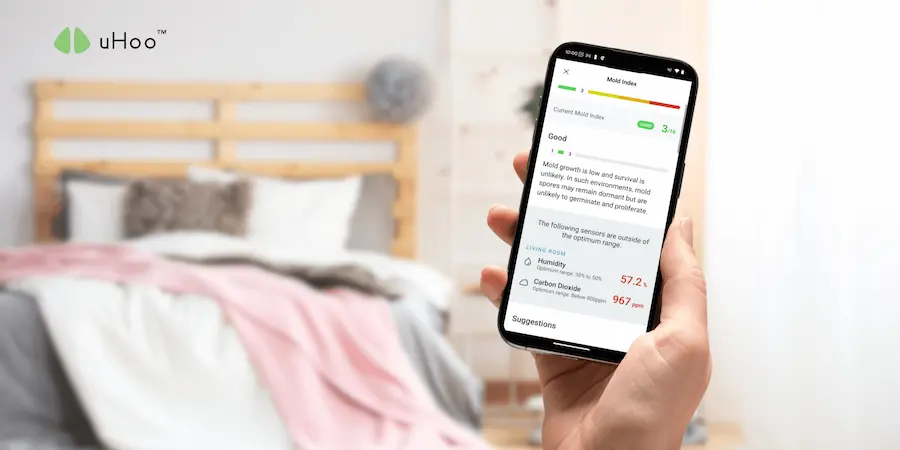That musty smell, a sudden increase in allergies, or unexplained respiratory irritation might make you wonder: is mold hiding in your home? In a perpetually humid climate like Pasay City, hidden mold is a very real possibility, often growing silently behind walls, under floors, or within air conditioning ducts where you can’t see it.
The key to answering the question, “is mold hiding in your home?” lies not just in a visual inspection, but in understanding your indoor environment, and that’s precisely where your uHoo air quality monitor becomes your most valuable detective.
While your uHoo doesn’t directly “see” mold, it provides critical data that tells you if the conditions for mold growth are present, and if its byproducts are affecting your air. Here’s what uHoo can tell you about your humidity and the potential for answering the question, “is mold hiding in your home?”
- Consistently High Relative Humidity (RH): The Biggest Clue.
- What uHoo Shows: Your uHoo displays real-time Relative Humidity (RH) levels. If these readings are consistently above 60% (especially 70% or higher), it’s a major red flag. Mold can start growing on surfaces within 24-48 hours when humidity levels are persistently high.
- What it Means for Mold: High RH means there’s enough moisture in the air for mold spores to absorb, germinate, and begin to colonize surfaces. Even if you don’t see condensation, high ambient humidity provides the necessary “water activity” for mold to thrive on organic materials.
- Your Action: If uHoo shows high RH, it’s time to act immediately: use a dehumidifier, improve ventilation, fix any small leaks, and ensure your AC is effectively dehumidifying.
- Spikes in Particulate Matter (PM2.5): Airborne Spores.
- What uHoo Shows: Your uHoo monitors tiny airborne particles, including PM2.5. Mold releases microscopic spores into the air, especially when disturbed or when a colony is actively growing.
- What it Means for Mold: If your PM2.5 levels are unusually high, particularly when there’s no obvious dust source, and especially if combined with high RH, it could indicate that mold spores (or fragments) are airborne. This often happens if mold is growing in a hidden area (like inside AC ducts or behind drywall) and its spores are being circulated.
- Your Action: Investigate the source. Clean AC filters, check ducts, and inspect any damp or musty-smelling areas. Consider professional mold inspection if PM2.5 remains high with other indicators.
- Presence of Volatile Organic Compounds (VOCs): Mold Odors and Metabolites.
- What uHoo Shows: uHoo detects various VOCs, which are chemical gases. While many VOCs come from cleaning products or new furniture, some types of mold (especially actively growing ones) can emit their own VOCs as metabolic byproducts. These are often what cause that characteristic “musty” or “earthy” mold smell.
- What it Means for Mold: If your VOC readings are elevated, particularly if accompanied by a musty odor and high RH, it’s a strong indicator that mold is actively growing somewhere, even if hidden.
- Your Action: Look for damp areas, investigate musty smells, and enhance ventilation to remove these gases.
- Sudden Temperature Drops Leading to Condensation Risk:
- What uHoo Shows: uHoo monitors temperature. In a humid climate, if surfaces (like a cold wall or pipe) get significantly cooler than the ambient air, condensation can form.
- What it Means for Mold: While uHoo doesn’t directly show surface condensation, knowing the indoor temperature and humidity allows you to understand if conditions are ripe for it. Condensation provides liquid water directly to a surface, an immediate food source for mold.
- Your Action: Ensure good insulation, maintain consistent temperatures, and manage overall humidity to prevent dew point being reached on surfaces.
By paying close attention to what uHoo tells you about your humidity and other correlated air quality parameters, you gain an early warning system. It helps you answer the question, “is mold hiding in your home?” before it becomes a widespread, costly, and health-damaging problem, allowing you to take proactive steps for a healthier living environment.



